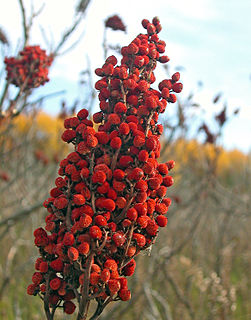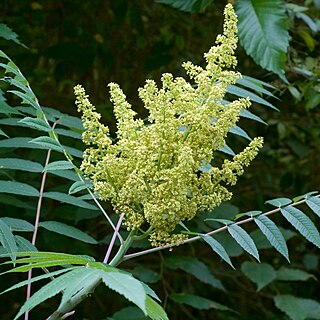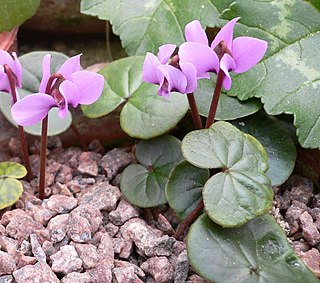
Toxicodendron is a genus of flowering plants in the sumac family, Anacardiaceae. It contains trees, shrubs and woody vines, including poison ivy, poison oak, and the lacquer tree. All members of the genus produce the skin-irritating oil urushiol, which can cause a severe allergic reaction. The generic name is derived from the Greek words τοξικός (toxikos), meaning "poison," and δένδρον (dendron), meaning "tree". The best known members of the genus in North America are poison ivy (T. radicans), practically ubiquitous throughout most of eastern North America, and western poison oak, similarly ubiquitous throughout much of the western part of the continent.

Toxicodendron radicans, commonly known as eastern poison ivy or poison ivy, is an allergenic Asian and Eastern North American flowering plant in the genus Toxicodendron. The species is well known for causing urushiol-induced contact dermatitis, an itchy, irritating, and sometimes painful rash, in most people who touch it. The rash is caused by urushiol, a clear liquid compound in the plant's sap. The species is variable in its appearance and habit, and despite its common name, it is not a true ivy (Hedera), but rather a member of the cashew and pistachio family (Anacardiaceae). T. radicans is commonly eaten by many animals, and the seeds are consumed by birds, but poison ivy is most often thought of as an unwelcome weed. It is a different species from western poison ivy, Toxicodendron rydbergii, which has similar effects.

Sumac, also spelled sumach, is any one of about 35 species of flowering plants in the genus Rhus and related genera in the family Anacardiaceae. It grows in subtropical and temperate regions throughout the world, especially in East Asia, Africa, and North America.

Urushiol is an oily mixture of organic compounds with allergenic properties found in plants of the family Anacardiaceae, especially Toxicodendronspp. and also in parts of the mango tree.

Toxicodendron vernix, commonly known as poison sumac, is a woody shrub or small tree growing to 9 m (30 ft) tall. It was previously known as Rhus vernix. This plant is also known as thunderwood, particularly where it occurs in the southern United States. All parts of the plant contain a resin called urushiol that causes skin and mucous membrane irritation to humans. When the plant is burned, inhalation of the smoke may cause the rash to appear on the lining of the lungs, causing extreme pain and possibly fatal respiratory difficulty.

Rhus typhina, the staghorn sumac, is a species of flowering plant in the family Anacardiaceae, native to eastern North America. It is primarily found in southeastern Canada, the northeastern and midwestern United States, and the Appalachian Mountains, but it is widely cultivated as an ornamental throughout the temperate world.

Toxicodendron pubescens, commonly known as Atlantic poison oak, is an upright shrub that can grow to 1 m (3 ft) tall. Its leaves are 15 cm (6 in) long, alternate, with three leaflets on each. The leaflets are usually hairy and are variable in size and shape, but most often resemble white oak leaves; they usually turn yellow or orange in autumn. The fruit is small, round, and yellowish or greenish. It is not closely related to true oaks.

Cypripedium kentuckiense, the Kentucky lady's slipper or southern lady's slipper, is a member of the orchid genus Cypripedium. Members of this genus are commonly referred to as lady's slipper orchids.

Rhus trilobata is a shrub in the sumac genus (Rhus) with the common names skunkbush sumac, sourberry, skunkbush, Squawbush, and three-leaf sumac. It is native to the western half of Canada and the Western United States, from the Great Plains to California and south through Arizona extending into northern Mexico. It can be found from deserts to mountain peaks up to about 7,000 feet (2,100 m) in elevation.
Regional floras typically contain complete dichotomous keys for identification of trees and other plants to species. The following guide originates from Our Native Trees and How to Identify Them by Harriet L. Keeler and applies to some flowering trees which are indigenous to the region extending from the Atlantic Ocean to the Rocky Mountains and from Canada to the northern boundaries of the southern states, together with a few well-known and naturalized foreign trees. This guide excludes conifers and is not an exhaustive list of all trees known to occur in the region.

Rhus glabra, the smooth sumac, is a species of sumac in the family Anacardiaceae, native to North America, from southern Quebec west to southern British Columbia in Canada, and south to northern Florida and Arizona in the United States and Tamaulipas in northeastern Mexico.

Illicium parviflorum, known locally as swamp star anise, is a species of flowering plant in the family Schisandraceae, or alternately, the Illiciaceae. It is native to Florida in the United States. It historically occurred in Georgia, as well, but it has been extirpated from the state. Its common names include yellow anisetree, yellow-anise, swamp star-anise, and small anise tree.
Chlorogalum parviflorum is a species of perennial herb known by the common name smallflower soap plant.
Epidendrum parviflorum is a small-flowered reed-stemmed Epidendrum orchid found in the montane tropical wet forests of Bolivia, Ecuador, and Amazonas, Peru.

Rhus aromatica, the fragrant sumac, is a deciduous shrub in the family Anacardiaceae native to North America. It is found in southern Canada and nearly all of the lower 48 states except peninsular Florida. It grows in upland open woods, fields, barrens, and rocky cliffs.

Cyclamen parviflorum, the small-flowered cyclamen is a perennial growing from a tuber, native to high elevations in the Pontic Mountains of northern Turkey. It is the smallest cyclamen species and the only one native to alpine tundra.

Poison ivy is an allergenic plant in the genus Toxicodendron native to Asia and North America. It is well known for causing urushiol-induced contact dermatitis, an itchy, irritating, and sometimes painful rash, in most people who touch it. The rash is caused by urushiol, a clear liquid compound in the plant's sap. The plant is variable in its appearance and habit, and despite its common name, it is not a true ivy (Hedera), but rather a member of the cashew and pistachio family (Anacardiaceae). T. radicans is commonly eaten by many animals, and the seeds are consumed by birds, but poison ivy is most often thought of as an unwelcome weed. Poison ivy was formerly treated as a single species, Toxicodendron radicans, but is now generally treated as a complex of three separate species: Toxicodendron radicans, Toxicodendron rydbergii and Toxicodendron orientale.

Brunellia comocladifolia, commonly known as the West Indian sumac, is a species of tree in the family Brunelliaceae. It is native to Central America, the West Indies, and northern South America.

Rhus boothillensis is an extinct species of flowering plant in the sumac family Anacardiaceae. The species is known from fossil leaves found in the early Eocene deposits of northern Washington State, United States. The species was first described from fossil leaves found in the Klondike Mountain Formation. Rhus boothillensis likely hybridized with the other Klondike Mountain formation sumac species Rhus garwellii, Rhus malloryi, and Rhus republicensis.
Rhus republicensis is an extinct species of flowering plant in the sumac family, Anacardiaceae. The species is known from fossil leaves found in the early Eocene deposits of northern Washington state in the United States. The species was first described from fossil leaves found in the Klondike Mountain Formation. R. republicensis likely hybridized with the other Klondike Mountain formation sumac species Rhus boothillensis, Rhus garwellii, and Rhus malloryi.
















